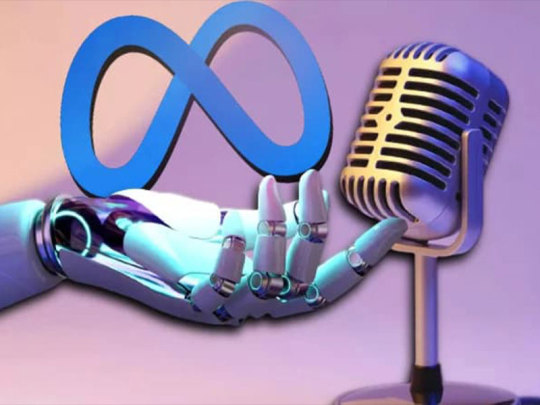#MusicGen
Explore tagged Tumblr posts
Text
2 notes
·
View notes
Text
Stable Audio 2.0: Generating Complete Musical Tracks

Music is an integral part of human expression, and with the advent of artificial intelligence, it is now possible to create music with the help of machine learning algorithms. Stable Audio 2.0 is the latest AI-powered tool that allows you to generate complete musical tracks with coherent musical structure.
Stable Audio 2.0 is a software that uses deep learning algorithms to analyze, understand, and then reproduce various musical genres. With this tool, you can create compositions that are up to 3 minutes long and contain distinct intro, development, and outro sections. The generated tracks are not only coherent but also sound like they were produced by a human composer.
The tool is user-friendly and easy to use. All you need to do is select the genre you want the music to be in, and then specify the length of the composition. You can also customize the tempo, key, and other parameters to get the desired output. Once you have set the parameters, the algorithm takes over and generates a complete musical track that you can use as a standalone composition or as a base for further refinement.
Stable Audio 2.0 is not just a tool for music production, but it is also a tool for music education. With its ability to generate different musical genres, it can help students learn more about music theory and composition. The tool can also help experienced composers break out of their creative rut and explore new genres and styles.
To get started with Stable Audio 2.0, visit their website, and sign up for a free trial. The tool is available for both Windows and Mac users. Once you have tried the tool, be sure to share your experience with us in the comments below.
In conclusion, Stable Audio 2.0 is a revolutionary tool that is changing the way we create music. It is a testament to the power of AI and its ability to augment human creativity. With this tool, anyone can create a complete musical track with ease, regardless of their musical background. So, go ahead and give it a try, and who knows, you might just create the next big hit!
0 notes
Text
Branding can reach new heights with meta's new release of an open-source AI-powered music generator called MusicGen that can create new pieces of music from text input and can optionally be based on existing melodies.
0 notes
Text
Do you love music and AI? Then you will love MusicGen, a new AI model by Meta Research that can generate music based on text and melody inputs. It can produce high-quality music samples with various instruments, genres, and styles, while matching the style and melody of the input. Read our blog post to learn more about this revolutionary model and how to access it. Continue Reading
#MusicGen#AI#Music#MetaAI#MetaResearch#AIMusicGeneration#text2music#deeplearning#machinelearning#artificial intelligence#machine learning
0 notes
Text
Everything You Need to Know About Using ChatGPT for Music Search

ChatGPT has been the driving force in 2023’s AI boom. It has become somewhat synonymous with generative AI models, as one of the most powerful large language models (LLMs). Its accessibility to the public through its free model has given hundreds of millions of people the opportunity to use sophisticated AI assistance in their daily lives.
The ChatGPT API has sparked a new era in human-machine interaction, making it easier to build a powerful language-based search for almost anything – including music. Many companies have since set up their music search using text prompts.
Despite its convenience and user-friendly platform, there are risks to using the platform for your music search. First, ChatGPT’s ability to get access to valuable music data for free is concerning. Second, there are concerns around OpenAI’s dependency on Microsoft. Third, ChatGPT’s progression to a monopoly will make it difficult for other genAI companies to set the tone in the market – and give OpenAI a uniquily strong negotiation position. Finally, there are ethical concerns about ChatGPT’s use of training data.
Using ChatGPT in Your Music Search
Before exploring these risks, it is useful to see how and why people are using it in their music search, as there a couple of ways in which it is being used.
In the first scenario, a user tells ChatGPT to translate text prompts into any given tagging taxonomy. For instance: “I need a song that sounds like Pirates of The Caribbean and it needs to feature a trumpet”. ChatGPT does a reasonably good job of translating it into keywords such as orchestral, adventurous, swashbuckling, dramatic, and trumpet. Based on these keywords, the user can search for suitable content. It’s a fairly straightforward music search but only works for very limited use cases.
The second scenario requires a pre-trained AI system that extracts comprehensive information from audio files, in the same way that ChatGPT extracts information from text prompts. Based on this, users can build a more seamless prompt search, comparing the text embedding to the audio embeddings in their music catalog. It’s a bit harder to build but translates into better results.
The Data You Feed ChatGPT
Whenever someone uses ChatGPT for music search, they are essentially providing ChatGPT with free access to valuable data; teaching it how humans describe music, what we find particularly important in music, how we perceive it, and how it makes us feel. Every music search prompt is essentially a glimpse into our musical minds.
OpenAI, ChatGPT’s parent company, has already released generative AI models that can generate music. These systems are operated by text prompts, but unlike ChatGPT, they generate music instead of text.
It is generally believed that generative AI in music such as Stable Audio, Google’s MusicLM, or Meta’s MusicGen lacks sophistication compared to human music creations – not only in terms of their sound quality but also how well the music fits the prompt. This is due to the training data that is available. These systems need full-text music descriptions and the corresponding audio files. The more complex and detailed the description, the better. But it is usually very expensive and time consuming to create or acquire this data, which is why genAI in music is still lacking the quality of LLMs.
However, conventionally tagged music is widely available, and enough to train good genAI models. The data gathered from a prompt-based music search can help OpenAI make much better connections between full-text prompts and tags, and thus generate suitable corresponding music to the text prompts.
For instance, if a user describes a film scene in a search prompt: “Give me a song that fits well to a scene where someone walks along Route 66 with their thumb out trying to hitchhike” and get underwhelming results, the user would add specificity, such as “sparse, blues, slide guitar”. In this moment chatGPT has made the connection between the film scene and the music tags.
Political Power-Play and OpenAI’s Dependency on Microsoft
Generating the amounts of text, as ChatGPT does, is very computationally heavy and expensive. According to reports, its daily operating cost is close to three-quarters of a million US Dollars.
Through their cloud service Azure, OpenAI’s biggest investor Microsoft is financing 99% of the cost. It’s not unreasonable to assume that eventually Microsoft will want to see a return on its investment, and that could mean a price increase for users of ChatGPT.
To make matters worse, the recent turmoil at OpenAI which saw CEO Sam Altman being dismissed only to be reinstated in his position days later raises questions about their internal cohesion and strategy. While things appear friendly on the outside, it is not far-fetched to imagine that this has led to an even bigger divide between OpenAI and Microsoft, which will undoubtedly have repercussions for the ordinary users of ChatGPT.
Progressing Monopolization
ChatGPT is undoubtedly the leader of the pack in the textual genAI game. Sure, competitors and tech journalists are keen to convince us that models such as LLaMA, Gronk, Gemini will lead to ChatGPT’s demise, but I’m not convinced. They may be formidable models, but it is unlikely that they can generate similar public attention and user numbers in the same amount of time.
This bears a substantial risk. There is a finite amount of training data on the internet. Most of the models above are mostly trained on the same information, hence they generate comparable answers to prompts. This is particularly problematic for music-related searches, which makes it harder to differentiate between the different LLMs.
To achieve differentiation, companies need to acquire data sources that will enable unique answers from their AI model. The only way this is possible is if they are generating training data proprietary to their company.
One of the most scalable ways is to harvest information from user interactions, which is why the elevated use of ChatGPT is a cause for concern. It stands far ahead of the competition purely based on the amount of accessible data it holds.
There will be a big difference in negotiating power for the music industry if one instead of several genAI companies are setting the tone for the entire market.
Ethical Concerns
Finally, there are significant concerns around the ethical use of training data. Many music companies were up in arms about genAI models because they claimed they were trained on unethically sourced datasets. Universal even urged Apple and Spotify to block genAI companies from accessing training data through their APIs.
The recent lawsuit from The New York Times against OpenAI does not give the impression that the training data was sourced with the consent of the copyright owners. In dubio pro reo, but what kind of message does it send if you are a music company that condemns using copyrighted music for training while using AI that was likely trained on unlicensed copyrighted text?
Conclusion
Text prompts will likely become the incumbent way of interacting with machines. And the music industry should not close its mind to this. However, when adopting this new trend, there are risks to consider. Using systems like ChatGPT can be a quick and easy way to let users search for music. However, there are clear downsides of giving up valuable data for free, whiling paving the way for a monopoly in this important area at the same time.
Apart from ChatGPT, there are search systems that allow for natural language search specifically for music. For instance, Azure OpenAI promises to not use any user data for retraining yet it's economic feasibility remains a question mark.
Join the conversation on AI ethics and innovation—explore more impact-driven insights on IMPAAKT today!
0 notes
Text
Generative AI – What is it and How Does it Work?
Generative AI is a type of artificial intelligence that is quickly becoming one of the most exciting technologies in the world. But what exactly is it? And how does it work? we’ll explain generative AI in simple terms and show you how it’s transforming industries and everyday life.
What is Generative AI?
Generative AI refers to a type of artificial intelligence that can create new things. Instead of just analyzing or predicting things, like some traditional AIs, generative AI actually produces new content. This content could be anything—from writing stories or poems, to generating images, music, or even video games.
For example:
It could write a brand-new article based on the topics you give it.
It could create a beautiful piece of artwork after learning from famous painters.
It could even compose music based on a certain style or mood.
How Does Generative AI Work?
Generative AI works by using machine learning, a type of AI that teaches computers to learn patterns from data. Here’s a simple breakdown of how it works:
TrainingGenerative AI is first “trained” by feeding it large amounts of data—like text, images, or sounds. The AI looks at this data and learns how different elements work together. For instance, if it’s being trained to write stories, it will look at thousands of books or articles to learn sentence structure, vocabulary, and tone.
GeneratingOnce the AI has learned from the data, it can begin generating new content. If you give it a prompt, like "write a short story about space," the AI will use what it has learned to create a new story that matches the prompt.
RefiningThe more the AI generates, the better it gets. It can refine its creations based on feedback from humans or its own learning process, making its results more accurate and creative over time.
Where is Generative AI Used?
Generative AI is already making an impact in many industries. Here’s a look at some of the places where it’s being used:
Art and DesignArtists and designers use generative AI to create new artworks, logos, or design ideas. It can help create unique designs quickly or give inspiration for new artistic projects.
Content CreationGenerative AI can write articles, blogs, and even books! It can also create scripts for videos or social media posts. Many content creators use it to save time and come up with fresh ideas.
MusicGenerative AI is helping musicians by composing new music. It can create songs in various genres or styles, offering musicians inspiration or even fully produced tracks.
Video GamesIn the gaming world, generative AI is used to create new game levels, characters, or even entire worlds. It can make games more dynamic and personalized, offering players a fresh experience each time they play.
HealthcareGenerative AI is being used in healthcare to create new drug formulas or discover new ways to treat diseases. It can quickly analyze medical data and propose solutions, making the process of finding new treatments faster and more efficient.
How Will Generative AI Affect You?
Generative AI isn’t just for businesses and professionals—it has an impact on everyday users too. Here are some ways it could affect you:
Personalized ContentGenerative AI can help create personalized recommendations, whether it’s movies, music, or articles. It learns from your preferences and can suggest content that you might enjoy.
Creativity BoostEven if you’re not a professional artist or writer, you can use generative AI to help with your own creative projects. You could use it to write poems, design posters, or even create your own music.
Smarter ServicesIn the future, generative AI could make customer service smarter and more efficient. You might be chatting with an AI that can quickly solve your problems or answer your questions.
Faster Problem SolvingGenerative AI can help solve problems faster, whether it's in business, healthcare, or education. It can analyze large amounts of data and generate solutions quickly, giving humans more time to focus on important tasks.
Challenges of Generative AI
While generative AI is amazing, it comes with its own challenges:
Ethical ConcernsGenerative AI can create content that looks real but isn’t. This raises concerns about misinformation, like AI-generated fake news or deepfake videos. We need to ensure it’s used responsibly.
Job DisplacementSome tasks, like writing or design, could become automated with generative AI, which may change job roles in the future. However, AI will also create new opportunities in tech and creative industries.
Quality ControlAlthough generative AI can create amazing things, it sometimes makes mistakes. It may create content that doesn’t make sense or isn’t up to standard. That’s why human oversight is still important.
Final Thoughts
Generative AI is an exciting technology that is transforming the way we create and interact with the digital world. It’s helping people in art, music, writing, healthcare, and many other industries. While it’s still evolving, the future of generative AI is bright, and it will continue to have a huge impact on our daily lives.
Stay updated with the latest trends and innovations in AI. Keep in touch with us to learn more about how generative AI is shaping the future.
0 notes
Text
オープンソースの音楽生成AI「Audiocraft (MusicGen)」のローカル環境導入と、無料で高品質な楽曲を制作する手順を解説
Meta社のAudiocraft音楽生成AIの優位性 Meta社が開発したAudiocraftは、音楽業界に革新的な変化をもたらす音楽生成AIです。 一般的な音楽生成AIと異なり、テキストプロンプトから驚くほど高品質な楽曲を生成できます。 オープンソースで提供されており、商用利用も視野に入れた開発が進められています。 MusicGenモデルの高度な音楽生成能力 MusicGenは、Audiocraftの主力モデルとして位置づけられています。 2万時間以上の音楽データを学習基盤とし、多様なジャンルの楽曲生成に対応します。 クラシック、ジャズ、ポップスなど、ジャンルを問わず高品質な楽曲を生成可能です。 AudioGenとEnCodecの補完的機能 AudioGenは環境音や効果音の生成に特化し、EnCodecは音声圧縮と復元を担当します。 この3つのモデルが連携することで、プロフェッショナル…
0 notes
Text
Music Licensing Simplified – Key Insights for Artists
Music licensing serves as the backbone of the music industry, ensuring creators and rights holders are compensated for their work. As the music landscape becomes more digital, licensing plays an even more crucial role. For artists, understanding the basics of licensing can mean the difference between profiting from their creations and losing out on revenue. Whether you're an independent musician or part of a larger production company, navigating the complexities of licensing is essential for success.
The Basics of Music Licensing
Music licensing is essentially the process of granting permissions for music to be used in various contexts, such as films, advertisements, streaming services, or live performances. When someone wants to use a song, they need the rights holder’s approval, which often involves paying royalties. Licensing agreements ensure the original creator is recognized and compensated for their work.
Technological advancements like Musicgen Meta are simplifying this process, especially for independent artists. These tools not only aid in music creation but also help artists manage their rights effectively, making licensing less daunting.
Why Licensing Matters
Licensing protects intellectual property (IP), which is a crucial asset for creators. Without proper licensing, artists risk losing control over how their work is used and may not receive fair compensation. Moreover, licensing ensures that music used in commercial or public settings adheres to copyright laws.
For instance, companies like Universal Music Publishing Group have been instrumental in managing licensing for some of the biggest names in the industry. They handle everything from mechanical licenses for streaming to synchronization licenses for movies, ensuring artists are fairly compensated across the board.
Types of Music Licenses
There are several types of music licenses, each tailored to different usage scenarios. Understanding these can help artists better protect their work:
Mechanical Licenses – For reproductions of music, such as CDs or digital downloads.
Synchronization Licenses – For music used in audiovisual projects like movies or advertisements.
Public Performance Licenses – For live performances or radio airplay.
Master Licenses – For using a specific recording of a song.
Each license serves a unique purpose, and knowing which one applies to your music is critical for monetization.
Simplifying Licensing with Technology
The rise of digital tools like Musicgen Meta has been a game-changer for artists navigating licensing. These platforms not only streamline the creative process but also integrate features to manage copyrights, making it easier for artists to track where and how their music is being used.
For example, if a musician wants to distribute their work across multiple platforms or license it for a film, Musicgen Meta can provide templates and tools to facilitate these agreements. This minimizes the chances of licensing disputes and ensures transparency in revenue sharing.
Challenges in Licensing for Different Genres
Genres often come with their own set of licensing challenges. For instance, Pop Music vs. Rock Music have different licensing demands based on their usage and audience reach. Pop music, often featured in commercials and mainstream media, requires synchronization and public performance licenses in large volumes. Rock music, with its strong live performance culture, leans heavily on public performance and mechanical licenses.
These differences highlight why artists must tailor their licensing strategies to their genre. Understanding the specific requirements of their musical style can help them maximize their revenue and exposure.
Iconic Brands and Licensing
The involvement of major brands in the music industry has further complicated the licensing landscape. For example, exploring Who Owns Beats by Dre sheds light on how music and technology companies collaborate to redefine licensing. Beats by Dre, known for its high-quality headphones, also works closely with artists and producers to license music for promotional campaigns.
This intersection of music and branding demonstrates how licensing extends beyond traditional boundaries. Brands use music to create an emotional connection with their audience, and proper licensing ensures that artists benefit from these partnerships.
Music Publishing and Licensing
At the heart of music licensing lies the process of music publishing. Companies like Universal Music Publishing Group play a pivotal role in ensuring that songwriters and composers receive their due share. Music publishing involves managing the rights of a song, from copyright registration to royalty collection.
For independent artists, understanding the basics of Music Publishing can be a stepping stone toward effective licensing. Many publishing companies now offer online tools and resources, making it easier for artists to navigate this complex field.
Licensing in the Digital Age
The digital era has transformed the way music is licensed. Streaming platforms like Spotify and Apple Music rely heavily on licensing agreements to pay artists. However, this shift has also introduced challenges, such as ensuring fair royalty distribution.
Artists who embrace tools like Musicgen Meta and partner with reliable publishing groups can stay ahead in this evolving landscape. Licensing agreements in the digital age must be more comprehensive, covering everything from digital downloads to micro-licensing for social media platforms.
Practical Tips for Artists
For artists looking to simplify the licensing process, here are some practical tips:
Educate Yourself: Understand the different types of licenses and their applications.
Leverage Technology: Use platforms like Musicgen Meta to manage copyrights and licensing.
Partner Wisely: Collaborate with established publishing groups like Universal Music Publishing Group for guidance.
Know Your Genre: Tailor your licensing strategy to your genre’s specific needs, whether it’s Pop Music vs. Rock Music or another style.
Seek Professional Help: Consult with music attorneys or licensing experts for complex agreements.
Conclusion
Music licensing may seem daunting, but it is a vital aspect of an artist’s career. With the right tools and knowledge, navigating this landscape can be simplified. From leveraging AI-driven tools like Musicgen Meta to collaborating with industry leaders such as Universal Music Publishing Group, artists can protect their rights and maximize their revenue.
As the industry continues to evolve, staying informed and adaptable is key. By mastering the art of licensing, artists can ensure their work reaches wider audiences while receiving fair compensation.
What’s your take on music licensing? Share your experiences or questions in the comments below!
0 notes
Text
Best Suno Alternatives for Music Creation in 2024
Discover creative tools that simplify music creation and spark inspiration.

The music industry is going through a significant change with the rise of AI music generators. These innovative tools allow for the creation of unique and engaging musical pieces without needing extensive technical skills.
AI as a creative partner is now a reality, reshaping how we produce and enjoy music. One notable tool in this field is Suno, which is recognized for turning user inputs into beautiful compositions, complete with catchy lyrics and melodies. However, some users have raised concerns about the similarities in the music produced, wishing for more variety and originality. If you find these issues relatable or are simply curious about other options, this blog post will introduce you to some top alternatives.
Udio
Udio allows you to create personalized music tailored to specific moments and experiences in your life.
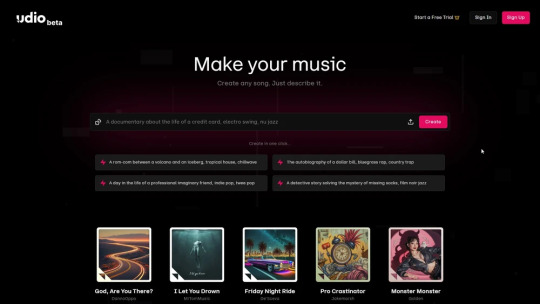
MusicGen
MusicGen by Meta AI generates versatile high-quality music using transformers, processing text or melody, with chromagrams.

Remusic
Remusic is a revolutionary AI tool transforming music creation and enjoyment, signaling the future of AI-generated music.
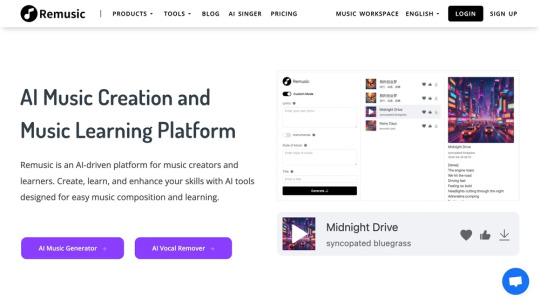
Tad AI
Tad AI provides fast custom royalty-free music generation for musicians, creators, and businesses using AI-generated lyrics and prompts.
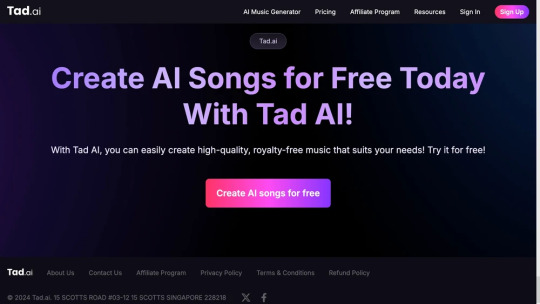
Donna AI
Donna AI transforms ideas into songs, offers royalty-free creations, community sharing, with vocal/instrument isolation.
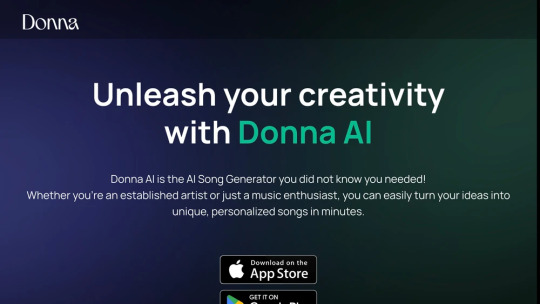
AI music generators have transformed the way we approach music production, making it more accessible and creative. Whether you're looking to enhance your social media with engaging background music or add a touch of drama to your videos, these tools provide a variety of features to suit your needs. They make music creation more inclusive, allowing for personal expression, with some even available without a subscription, while also helping you avoid potential copyright issues.
As you consider these options, keep in mind that the key is to find a tool that aligns with your creative vision and supports your musical projects.
For more blogs like this: thenextaitool.com/blog
0 notes
Photo

Generative AI's New Sound Waves
Generative AI isn't just for text anymore; it's making some serious noise in the audio world.
1. Stability AI's StableAudioOpen
Text-to-Audio Magic: Converts text prompts into recordings up to 47 seconds.
Royalty-Free Assurance: Trained on royalty-free recordings, with a transparent process to ensure compliance.
Open Source with a Catch: Open source but non-commercial; commercial use requires a fee. You can fine-tune it with your custom data.
2. Eleven Labs' Sound Effects
Short and Sweet: Generates audio snippets up to 22 seconds.
Licensed Data: Uses Shutterstock's licensed data for training.
Limited Free Tier: Offers a couple of free snippets, but it's more closed-sourced compared to StableAudioOpen.
3. Existing Sound Generators
Meta's AudioCraft Library: Includes MusicGen for music and AudioGen for sound effects, both open source under MIT license.
Other Players: Google’s MusicFX and OpenAI’s Shootbox exist but aren't as popular.
Generative AI is revolutionizing audio creation. Dive in, experiment, and let us know how these tools amplify your projects!
#artificial intelligence#automation#machine learning#business#digital marketing#professional services#marketing#web design#web development#social media#tech#Technology
1 note
·
View note
Text
AI music editor developed by Sony and researchers can modify songs with text prompts
Researchers at Queen Mary University of London, Sony AI, and MBZUAI's Music X Lab have developed an AI system called Instruct-MusicGen that can modify existing music based on text prompts.
0 notes
Text
第17回活動
2024/06/14
今日も暑いですね〜 なのに大学の冷房が効きすぎていて、体調崩しそうです... プロジェクトも折り返しなのは早いですね
今日も主にポスターとWebサイトに載せる文章と内容を考えていました! また、マイルストーンを決めるにあたって外部発表はどこでやるか?どのくらいの仕事量なのかが徐々に明確になってきました🤗 ↓以下本日の活動です!
本日の予定
(1)今日やる事の確認(2分) (2)プロジェクトの概要(11:15まで) (3)ポスターやサイトに載せる文章(12:05まで) (4)各グループの共有や報告あれば何か(2〜5分) (5)次回以降の予定など話し合い(残り時間)
プロジェクトの概要
ポスター用
一般的に、音楽は「聴くもの」として楽しまれています。しかし、音楽にはもっと多様な可能性があると思います。そこで私たちは、音楽の表現の可能性を広げ、新しい楽しみ方を見つけようと考えました。
このプロジェクトでは、性格診断の結果を基に音楽を作り、その音楽をARアートと結びつけることで、「聴くもの」という枠を超えた新しい音楽表現を創り出すことを目指しています。私たちは、音楽と性格の融合、そして音楽とARアートの融合という二つの側面から、音楽の楽しみ方と新しい表現方法の発見に挑戦します。
↑概要では「音楽と性格の融合、そして音楽とARアートの融合という二つの側面から、音楽の楽しみ方と新しい表現方法の発見に挑戦します。」の部分をなくし、各チームの活動の詳細を書く
目標→マイルストーン 目的を達成するための具体的な活動のことで目的の欄に書かなくてもよい

テーマ
音楽の新たな表現を見つける
〜性格を聴こう、音楽を視よう〜
・音楽は「聴くもの」という固定観念がある→音楽を聴覚以外で捉え新しい表現の仕方を見つけようと考えた →ここに論理の飛躍があると感じる。間に目的がある
・音楽は「聴くもの」 →人によっては「作るもの」「使うもの」という人もいるがこの部分をどうするか
プロジェクト概要(改善案)
一般的に、音楽は「聴くもの」として楽しまれています。しかし、音楽にはもっと多様な可能性があると思います。そこで私たちは、音楽の表現の可能性を広げ、新しい楽しみ方を見つけようと考えました。
このプロジェクトでは、性格診断の結果を基に音楽を作り、その音楽をARアートと結びつけることで、「聴くもの」という枠を超えた新しい音楽表現を創り出すことを目指しています。具体的には、性格診断を元に音楽生成AIを用いて、それぞれの性格に合ったオリジナルの音楽を生成します。そして、生成された音楽をアートに変換し、ARとして体験できるようにします。
私たちは、音楽と性格の融合、そして音楽とARアートの融合という二つの側面から、音楽の楽しみ方と新しい表現方法の発見に挑戦します。
ポスター・サイトに載せる文章
サイト
・プロフィールに一言コメントと、各自が生成した性格を表した曲を載せる ・音楽に関するプロジェクトなので好きな曲も載せたい
各グループの具体案
音楽生成グループ ・性格と音楽を結びつける ・性格診断を元に、音楽生成AIを用いてオリジナルの音楽を生成する。 ・そのシステムをソフトウェアまたはサイトとして利用できるようにする。
ARアートグループ ・音楽とARアートを結びつける。 ・生成された音楽をもとに、アートを作る。 ・作成したアートを、ARとして体験できるようにする。 ・予想される成果物
音楽生成グループの成果物
自らの性格を知るために最も確実な手段として性格診断を選択。その結果を音楽に変換するために音楽生成AIを使うことにした。 「ビッグファイブ性格診断」という10問からなる性格診断と独自に用意した設問の結果を音楽要素に変換し、それをプロンプト(AIへの指示文)に落とし込む。 そのプロンプトを音楽生成AI「SunoAI」に入力し、ユーザーを表現したオリジナルの音楽を生成する。 現状はソフトウェアの完成を目標としている。Pythonを使い、GU(not洋服屋)Iのあるソフトで性格診断の情報を入力し、その情報を下にプロンプトを作成する。作成したプロンプトをSunoAIに送信し、生成された音楽を受け取って再生する機能を実装する。
現在の達成状況
音楽生成グループ
AIの評価(Suno,Mubert,MusicGen)の3つの生成AIを比較。調査の結果から音楽生成AIとしてSunoを選択。 性格診断は当初は独自のものを���ろうと考えていたが、より信頼性の高いビッグファイブ性格診断を使うことにした。 本来質問数が120問あるが、より手軽に作れるようにするため10問の簡易版を使うことにした。(結果に大きな差異はない) 論文などから性格要素と音楽要素の関連を調べ、プロンプトのver1を作成 性格診断の結果によってプロンプトが同じようなものが生成されてしまうため、現在はプロンプトを随時更新しより良いプロンプトの模索を進めている状況 ・性格診断からプロンプトを作るという流れは完成 ・プロンプトのブラッシュアップを続ける ・APIを使用して生成AIへの接続を行えるプログラムの制作を始めたところ
予想される成果物
ARアートの成果物 ・音楽を、印象空間を用いてアートに変換する 印象空間:音楽を聴いた印象語の程度を表にプロットしたもの 性格診断結果から、印象空間を介して、アートにプロットする要素、(季節、天気、時間帯に分解し、各要素の組み合わせをオブジェクトとしてARで投影する。 ・季節に対応する木、天気に対応する空模様、時間帯に対応する明るさ(暗さ)のアートを作成 ・性格診断結果から各印象語の程度に変換・印象空間にプロット ・各属性の印象座標と距離が近いアートを出力
1.季節に対応する木、天気に対応する空模様、時間帯に対応する明るさ(暗さ)のアートを作成 →季節、天気、時間の属性に対応するアートを作成しておく (Blenderの画面(オブジェクト)のスクショ)
2.性格診断の結果から各印象語の程度に変換・印象空間にプロット →性格診断の結果からその人に合ったイメージを散布図の座標に当てはめる (印象語が印象空間にプロットされている感じのイラスト)
3.各属性の印象座標と距離が近いアートを出力 (印象空間からアートが飛び出している感じのイラスト) 変換されたアートをUnityでARにして、UnityライブラリのZapparでWeb上に公開する。また、カード型のマーカーを媒介として、ARを手元で体験できるようにする。←横にイラストか写真を載せる
次回の予定案
(1)今日やる事の確認(2分) (2)本日の雑学(5分)根本さん (3)代表者会議の報告 (4)ポスターなどについて、小杉先生に助言をもらう(10分) (5)各グループ作業(12:05まで) (6)各グループの共有や報告あれば何か(3分) (7)次回以降の予定など話し合い(7分) ※教員に相談に行くことがあれば変更するので、予定が前後することあり
0 notes
Link
Researchers from C4DM, Queen Mary University of London, Sony AI, and Music X Lab, MBZUAI, have introduced Instruct-MusicGen to address the challenge of text-to-music editing, where textual queries are used to modify music, such as changing its style #AI #ML #Automation
0 notes
Quote
Audiocraft is a library for audio processing and generation with deep learning. It features the state-of-the-art EnCodec audio compressor / tokenizer, along with MusicGen, a simple and controllable music generation LM with textual and melodic conditioning.
facebookresearch/audiocraft: Audiocraft is a library for audio processing and generation with deep learning. It features the state-of-the-art EnCodec audio compressor / tokenizer, along with MusicGen, a simple and controllable music generation LM with textual and melodic conditioning.
0 notes
